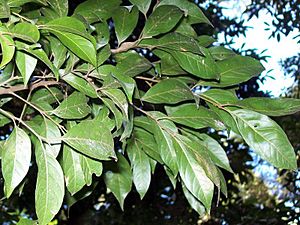Steelwood facts for kids
Quick facts for kids Steelwood |
|
|---|---|
 |
|
| Sarcopteryx stipata - leaves | |
| Scientific classification | |
| Genus: |
Sarcopteryx
|
| Species: |
stipata
|
The Steelwood tree, also known as Sarcopteryx stipata, is a special tree found in the rainforests of eastern Australia. It grows from the Bulga Plateau and Comboyne Plateau in New South Wales up to Fraser Island in Queensland.
Steelwood trees usually live in warm, wet rainforests. Sometimes, they can also be found in slightly cooler rainforests with less rich soil. This tree belongs to the soap berry family. Its scientific name, Sarcopteryx, means "fleshy wing." This is because its fruit can look like it has wings. The word Stipata means "surrounded." People call it Steelwood because its wood is super strong, hard, and heavy, just like steel!
Meet the Steelwood Tree
The Steelwood tree is usually a small tree. It often grows up to 10 metres (about 33 feet) tall. But some can grow much taller! One huge Steelwood tree was found in Nightcap National Park. It was 40 metres (about 131 feet) tall. Its trunk was about 75 cm (30 inches) wide.
The bottom part of larger Steelwood trees can look a bit wide or flared. The bark is hard and grey. It often has interesting patterns like wrinkles, lines, and bumps. The smaller branches are thick. They have ridges along them and soft brown hairs. Many parts of the plant have these soft brown hairs.
Steelwood Leaves: A Closer Look
Steelwood trees have special leaves called compound leaves. This means each leaf is made up of several smaller leaflets. These compound leaves are usually 9 to 18 cm (3.5 to 7 inches) long. Each leaf has about six leaflets, but sometimes it can have three to nine.
The leaflets are 4 to 10 cm (1.5 to 4 inches) long. They are also 1.5 to 4 cm (0.6 to 1.6 inches) wide. They have a broad, spear-like shape. They are narrow at the bottom and have a long, thin tip. The two halves of each leaflet are not exactly the same size. The top side of the leaflets is shiny green. The bottom side is duller and has some brown hairs.
The main stalk of the compound leaf is brown and hairy. It is swollen where it connects to the branch. The small stalks that hold each leaflet are 3 to 12 mm (0.1 to 0.5 inches) long. The veins on the leaves are easy to see on both sides. Some side veins get wider and thicker where they meet the main vein of the leaf.
Steelwood's Life Cycle: Flowers and Fruit
Steelwood trees produce white or cream-colored flowers. These flowers grow in clusters called panicles. They appear from August to October. You can find them at the end of the branches or where the leaves join the stem (called the axil). Each flower petal is about 2 mm (0.08 inches) long.
The fruit of the Steelwood tree is a red or pink capsule. It is about 13 mm (0.5 inches) across. The fruit has three or four sides or angles. Inside, it has three small sections, called cells. Each cell holds one shiny, brown, cylinder-shaped seed. These seeds are about 5 mm (0.2 inches) wide. A yellow, fleshy covering, called an aril, completely covers each seed.
The fruit ripens in November and December. Birds like the green catbird and Lewin's honeyeater enjoy eating them. If you want to grow a Steelwood tree from a fresh seed, it might take a while. But it usually works! It's a good idea to remove the yellow aril from the seed first. After about four months, almost all the seeds should sprout.

